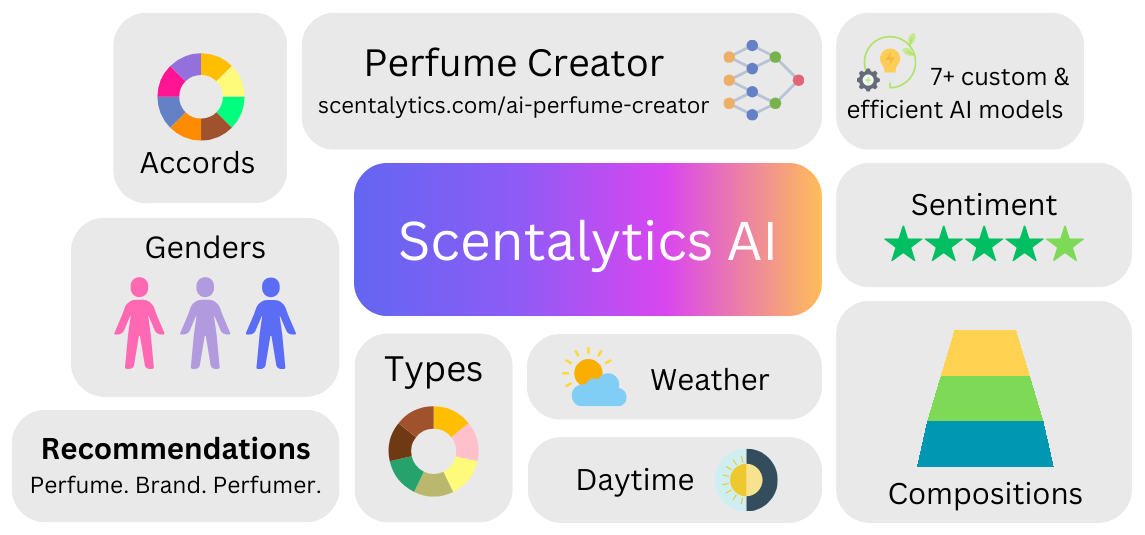AI Perfume Creator 2.0: Your Companion for Fragrance Design
Introducing the Scentalytics AI Perfume Creator 2.0: Your trusted companion in the art of fragrance design.
The Scentalytics AI Platform comprises over 10 interconnected neural networks, each designed to predict specific aspects of a given perfume composition. These aspects include perfume accords and types, gender appeal, seasonal and daytime suitability, as well as potential consumer sentiments and ratings for the desired combination of perfume notes. Additionaly, the platform includes models that suggest personalities, emotions and colors that could be associated with a given fragrance composition.
Compared to current state-of-the-art Gen AI models, known as large language models (LLMs), our neural networks are significantly smaller, easier to manage and more energy-efficient. Since they are trained exclusively on specific data about perfume compositions, we believe they offer comparable performance to more general large language models, but at a much lower computational cost. This approach, which we term functional AI, represents a paradigm in AI application delivering specialized, task-specific solutions with trustworthy efficiency and precision.

The whole platform currently consists of several groups of in-house models:
This interactive web app demonstrates capabilities of our main AI models. As you add or remove different perfume notes, the AI models in the background are constantly calculating properties of the current perfume composition, and the charts are being updated accordingly. Such an approach guides the user to create a desired and personalized perfume creation with the help of AI, but still leaves the main creative process to human.
Once you’re done with your creation, you can check the real existing perfumes which are similar to your virtual composition. To find them, we don’t use pure keyword search, but rather the semantics of notes, accords and fragrance family of your creation. This is the reason why the results won’t always contain perfumes with exactly the same notes as yours, but they should be similar to your composition in terms of combined semantics of the main aspects of your fragrant creation.
This perfume recommendation engine is a part of our advanced scent profiling service, and is powered by one of our neural networks. To find similar perfume creations, it searches the database of little less than 40 thousand known perfumes. This database is updated on a yearly basis to contain new products.
The last, but not least feature is an Example formula. This highly experimental feature relies on the one of the newest and most powerful large language models out there. It enables perfumers and fragrance enthusiasts to see the suggested example formulations of chemical compounds for the given composition of perfume notes. You can learn more about this feature in our announcement about the AI Perfume Creator 2.0.
Our proprietary models are trained on a comprehensive dataset of publicly available information regarding perfume notes, compositions, and associated properties. While these models provide valuable insights, it's important to note that they currently operate without access to detailed perfume formulations, which may occasionally result in outputs that deviate from expert expectations.
However, we possess the capability to develop bespoke AI solutions tailored to specific industry needs, provided we have access to more refined and specialized data. This adaptability allows us to create highly customized tools that can address the unique challenges and requirements of our clients in the fragrance industry.
At Scentalytics, our primary goal is to provide innovative solutions that bring tangible value to our users and clients. We are also aiming to achieve wider adoption of our platform and the accompanying AI Perfume Creator. Furthermore, we are continuously developing new enhancements to our products that empower our clients to reach new heights in fragrance creation, all while preserving and amplifying their unique, irreplaceable human touch.
We hope that our work will help and inspire perfume creators in their search for new olfactory experiences. If you have any questions, suggestions or collaboration requests, feel free to drop us a message to hello@scentalytics.com. We will be more than happy to help you.